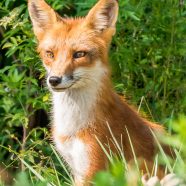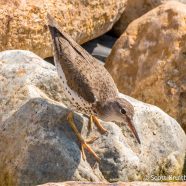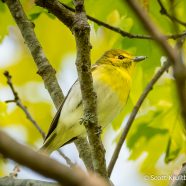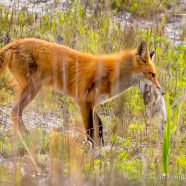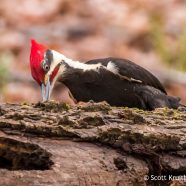Red Fox
I had not seen any Red Fox (Vulpes vulpes) friends for a while, but this one is clearly as healthy as any can be and looking great. Take a look at that exquisite coat with no sign of mange and no visible injuries to the animal. That in itself is very rare to see in a Red Fox, and without knowing too much I would hazard a guess that this is one of the pups born last year. It spotted me before I spotted it – per usual – and when I stopped it stopped and relaxed. I really do think they know “who” we are, like any dog would after a while, and it knew I was only going to...
Read MoreSpotted Sandpiper
The Spotted Sandpiper (Actitis macularius) is one of our easier to identify shorebirds from any distance, and their unique behaviors make them a stand out from the crowd – literally. While you may run into large flocks of shorebirds numbering in the dozens, hundreds, or even thousands heading south in the summer along lakes, in marshes, or on the Atlantic coast, you will very likely find only one or two or a handful of Spotted Sandpipers at a time. Even if multiple Spotteds are present in one place they will probably be on different flocks, not bumping into one another or seeking the...
Read MoreYellow-throated Vireo
The Yellow-throated Vireo (Vireo flavifrons) seen here did plenty of singing and foraging for me on a recent spring morning while his mate tended to their new nest. They were located, as always, on the edge of a large forest, and while they love the cuts they do need sizable, unbroken woodlands. If you take a look at them from afar you may wonder why they have such a plumage…but if you look at some of my photos you may not have to ponder that anymore. What a perfect camouflage, especially in the spring! I have no doubt those looks help the species coax their insect prey into easy...
Read MoreRed Fox and Cottontail
It is terribly ironic that just hours after my colleague, Audubon Connecticut Director of Bird Conservation Patrick Comins, uploaded some lovely cottontail photos to the Audubon Connecticut at Stratford Point page that I found our vixen Red Fox engaged in some hunting early this morning. I felt some eyes on me as I surveyed for avian migrants along Prospect Drive, and she was watching me from within our side of the fence. This is nothing abnormal, and the interaction was typical – a little curious stare down at one another before we both continue on. However, she then put her attention...
Read MorePileated Woodpecker (Dryocopus pileatus)
Let’s switch gears from the little migrant birds to the big resident birds with this Pileated Woodpecker (Dryocopus pileatus) as photographed last week during its breakfast. This meal, while being obviously tasty and delicious, also provides us a lesson in forest and yard management. Most of the time Pileated Woodpeckers can be found eating at dying, dead or fallen trees like this one as they hammer away for ants and various insects associated with decaying wood. If we removed all of the rotting wood from the forest or our yards what would they have to eat? Not much! If you can safely...
Read More



